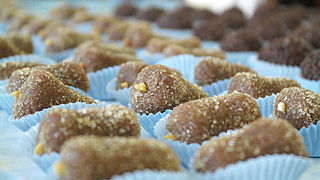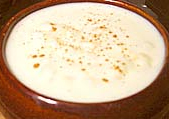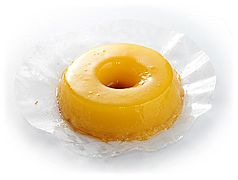List of Brazilian sweets and desserts
 |
| Part of a series on |
| Brazilian cuisine |
|---|
| Types of food |
| See also |
Below is a list of sweets and desserts found in Brazilian cuisine. Brazilian cuisine has European, African and Amerindian influences.[1] It varies greatly by region, reflecting the country's mix of native and immigrant populations, and its continental size as well. This has created a national cuisine marked by the preservation of regional differences.[2]
Desserts and sweets[edit]
A–E[edit]



- Açaí na tigela – a Brazilian dish made of frozen and mashed açaí palm fruit, it is served as a smoothie in a bowl or glass.[3]
- Amanteigado – a buttery cookie or biscuit
- Baba de moça
- Bananada
- Bem-casado
- Beijinho – a common Brazilian birthday party candy[4]
- Beijo de mulata
- Bijajica – a cookie
- Biriba or biribinha
- Biroró
- Bolo de rolo – a cake prepared using guava, it is recognized as a national dish by Brazilian law.[5]
- Bolo Souza Leão – a typical Pernambuco cake
- Bom-bocado – a coconut torte that is commonly served during Brazil's Independence Day[6]
- Brigadeiro – a traditional Brazilian confectionery
- Broinha de coco – a coconut-based biscuit-like dessert
- Bruaca
- Cacuanga[7]
- Cajuzinho – a popular sweet made of peanuts, cashew nuts and sugar and is shaped like a tiny cashew
- Camafeu de nozes
- Canjica – a popular Festa Junina sweet dish prepared using canjica corn[8]
- Carolina – An éclair-like dessert
- Cartola – a typical Pernambuco dessert
- Cavaca
- Chuvisco
- Cocada – a traditional coconut candy or confectionery found in many parts of Latin America
- Creme de papaya – a frozen dessert
- Cupulate – a chocolate-like dessert made using cupuaçu instead of cacao
- Curau – a sweet custard-like dessert made from the pressed juice of unripe maize, cooked with milk and sugar
- Doces Cristalizados
- Doce de abóbora
- Doce de espécie – typical dessert of the Northeast Region of Brazil
- Espuma de sapo
F–J[edit]
- Fatia de braga
- Fios de ovos – a traditional Portuguese sweet food made of eggs (chiefly yolks), drawn into thin strands and boiled in sugar syrup. They are a traditional element in Portuguese and Brazilian cuisine, both in desserts and as side dishes
K–O[edit]


- Mané-pança
- Mané pelado
- Manjar blanco – a term used in Spanish-speaking area of the world in reference to a variety of milk-based delicacies.[9]
- Manjar branco – a pure white Brazilian coconut pudding
- Maria-mole – similar to a marshmallow, its base ingredients are sugar, gelatin and egg whites, and it is usually covered in grated coconut
- Nhá Benta or "teta de nega", a chocolate-coated creamy marshmallow
- Mugunzá – a porridge made with white de-germed whole maize kernels (canjica), cooked with milk, sugar and cinnamon until tender. Other ingredients are also sometimes used.
- Olho-de-sogra – ("mother-in-law's eye" in Portuguese) is a Brazilian candy
P–T[edit]

- Paçoca – a candy made out of ground peanuts, sugar and salt
- Palha italiana – A Brazilian variant of the chocolate salami, consists of crushed biscuits (usually similar to Marie biscuits) mixed in brigadeiro
- Pão de mel - A little cake made of honey, filled with condensed milk cream and covered with a thin layer of chocolate
- Papo-de-anjo – a traditional Portuguese dessert made chiefly from whipped egg yolks, baked and then boiled in sugar syrup.[10]
- Pastel
- Pastel de Santa Clara
- Passion fruit mousse
- Pavê – a dessert similar to Tiramisu made using ladyfingers (known as "champagne biscuits" in Brazil) or a Marie biscuit equivalent, chocolate cream and condensed milk
- Pé-de-moleque – a candy made using peanuts, jaggery or molasses
- Pudim de leite moça [pt]
- Queijadinha – a candy that originated in Portugal, and is common in Brazil
- Quindim – a popular Brazilian baked custard dessert
- Rapadura – unrefined whole cane sugar
- Sweet rice – rice pudding
- Sagu – a southern Brazilian dessert, made with tapioca pearls, sugar and red wine, it is typical of the state of Rio Grande do Sul.
- Torta alemã (lit. 'german pie')
U–Z[edit]
Gallery[edit]
- Brazilian sweets and desserts
-
Commercially prepared pé-de-moleque
See also[edit]
References[edit]
- ^ Brittin, Helen (2011). The Food and Culture Around the World Handbook. Boston: Prentice Hall. pp. 20–21. ISBN 9780135074817.
- ^ "Way of Life". Encarta. MSN. Archived from the original on 2009-10-29. Retrieved 2008-06-08.
- ^ "Açaí, a Global Super Fruit, Is Dinner in the Amazon", The New York Times, February 23, 2010
- ^ Tatum, C.M. (2013). Encyclopedia of Latino Culture: From Calaveras to Quinceaneras. Cultures of the American Mosaic. ABC-CLIO. p. 429. ISBN 978-1-4408-0099-3. Retrieved July 5, 2019.
- ^ D, T.G.R.P.; Roufs, K.S. (2014). Sweet Treats around the World: An Encyclopedia of Food and Culture: An Encyclopedia of Food and Culture. ABC-CLIO. p. 399. ISBN 978-1-61069-221-2. Retrieved July 5, 2019.
- ^ Webb, L.S.; Roten, L.G. (2011). Holidays of the World Cookbook for Students: Updated and Revised. ABC-CLIO. p. 332. ISBN 978-0-313-38393-9. Retrieved July 3, 2019.
- ^ Maresch, Gustavo (27 October 2020). "Gastronomia tradicional da Ilha de Santa Catarina: açoriana ou manezinha?". Sistema Catarinense de Comunicações. Retrieved 6 September 2021.
- ^ Parés, L.N. (2013). The Formation of Candomble: Vodun History and Ritual in Brazil. Latin America in translation / en traducción / em tradução. University of North Carolina Press. p. 288. ISBN 978-1-4696-1092-4. Retrieved July 5, 2019.
- ^ Web Gastronomica de Enrique Domenech: Manjar Blanco Receta Archived 2009-12-23 at the Portuguese Web Archive, retrieved on 22-04-2007
- ^ Charles Gordon Sinclair (1998), International Dictionary of Food & Cooking. Taylor & Francis. ISBN 1-57958-057-2, ISBN 978-1-57958-057-5







